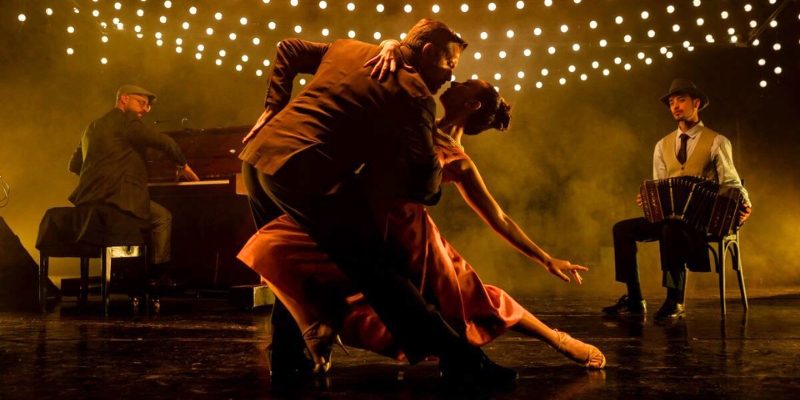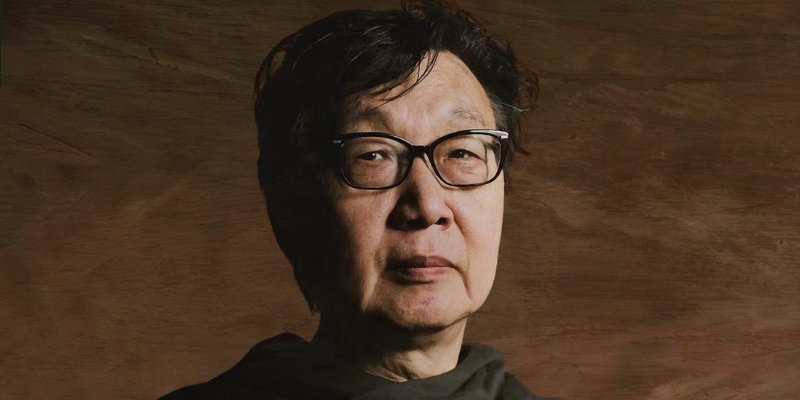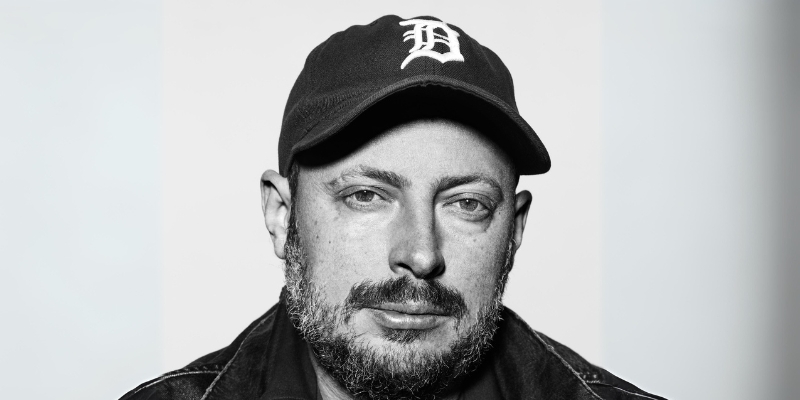Mary Ann Peters is an artist whose combined studio work, installations, public art projects and arts activism have made noted contributions to the Northwest and nationally for over 30 years. Most recently her work has focused on the overlap of contemporary events with splintered histories of the Middle East.
She will speak about her artwork at our upcoming event on Thursday, April 5th with Gary Faigin, who serves as Artistic Director at the Gage Academy of Art. In the meantime, Town Hall’s Jonathan Shipley spoke with her about migration, impossible monuments, and making the ugly beautiful.
Make sure to get tickets for her event on Thursday, April 5th.
JS: When you say your artwork is being informed by the migration crisis, what do you mean by that?
MAP: What I have been doing is researching migration patterns that happened at the turn of the 20th century out of what is what is now current day Lebanon and at that time, was Syria. And I’m looking at the pattern and the footprint of that movement through Europe into the Americas and making artwork about it. I’m comparing that historical record to contemporary events that are happening now and looking at how people are moving now.
I would argue, and I will say this, that there isn’t a migration crisis, there’s a humanitarian crisis and I’ve had enough experiences now being in Europe and also in Lebanon to be able to back that up a little bit.
That’s really what the crux, what the focus has been with my work.
You’re looking at the past 100 years or so, then, of that movement?
Yes. I’m comparing the footprint and the experiences 100 years apart.
What has been the most striking to you doing that comparison?
I’m not a researcher, really, I’m just a pretty good snoop, I guess. What I look for is under-noticed incidents that can, in some way, trigger an image I can make, or an installation I can make that would make people think about what would happen there.
Let me give you two historical differences. Syrian President Bashar Hafez al-Assad’s father, Hafez al-Assad – this isn’t a hundred years separation but it’s the lineage – attacked the city of Hama in 1982 and I found this by following the history of Hama. Assad’s father besieged the town of Hama for 27 days in order to quell an uprising by the Muslim Brotherhood against the government. He closed the borders and he closed the media and nobody really knew the extent of it until years later.
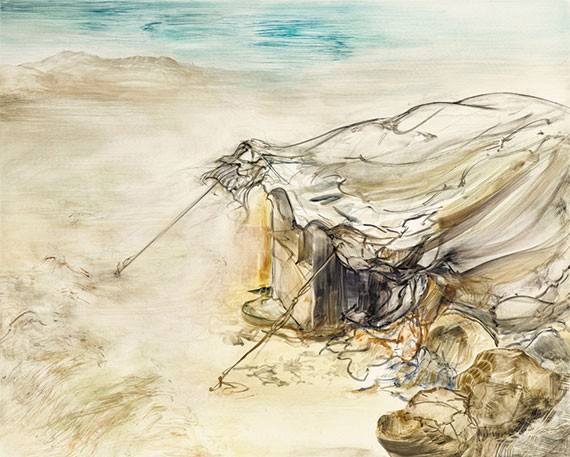
story board 2
watercolor, gouache on clayboard
16″x20″
2015
The reason I was following Hama is, for one, it’s a really beautiful city. It’s kind of the basis of farming country and it has this river that runs through it. It has an incredible aqueduct system with big water wheels in the river. In reading about that, I stumbled onto a ritual that happens. People go to the river in a ceremony. I think it happens once a year and they pour red dye into the river next to the water wheels and it churns up the water and turns it red. It’s like giving life blood back to the river and commemorating, at the same time, the people that died. That’s the way I’ve read the story. So, I made a painting called Painting the River Red as a consequence of reading about that.
In regards to your process – you read something like the red river – what inspires you to make a painting versus an installation versus a sculpture?
Which way can I best convey the narrative that I’m trying to suggest?
I have been doing a series, that I will be showing several pieces of during the event, called ‘impossible monuments.’ Those are based on contemporary information. Reading about Aleppo. Reading about the White Helmets. Reading about this incredibly beautiful historical site, one of the oldest continuously inhabited cities in the world and it’s being destroyed. That story got me.
But when you fly on an airplane and you look down it just looks like a beautiful pattern in this ground. You don’t necessarily see the destruction. That piece that I did about Aleppo that I named Ghosting, was about how people hold onto the memories of spaces that then, in turn, informs their holding onto their cultures.
I want to talk about the migration crisis, at the event, as a point of reference for the resilience of cultures that are in forced movement. I want to talk about footprints of cultures in various places that take a stronghold. They don’t move. They just get incorporated into the cultures that they have found themselves in.
You translate information and turn it into art.
I am an interpreter. I am not duplicating something that happened. I am interpreting something that happened. I am pulling up into the consciousness and into the visual framework for people things that they would not access, not see, not realize, and give it a physical form for them to take away with them to think about.
The very first ‘impossible monument’ that I made was I bronzed a set of pita breads. The reason I did it was because one of the big contributors to what’s happened in Syria in the beginning was drought. I don’t think people understood that. I don’t think they know that there was an uprising; that there was a protest by the farmers for the government to help them because there was a drought and their crops were failing. Most of those crops were tied to wheat, and wheat is what bread is made of and then there was a bread shortage. In the full range of people moving from rural settings to urban settings or moving onto refugee camps, this staple, this thing – it has so many layers of meaning, bread – was in jeopardy. It wasn’t a given that you could get a loaf of bread.
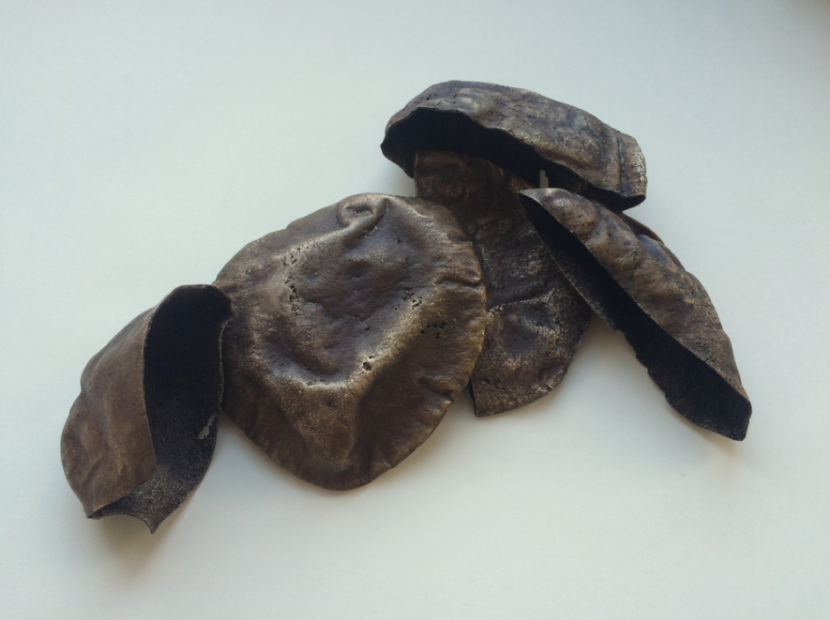
impossible monument
5 unique bronzes
scales variable, 6″-10″
2015
Your artwork seems to be shifting. Previously, it seemed to be of natural disasters, apocalyptic. Now, it’s more focused on a more personal and human element.
I think you’re right. The difference is there’s more of a sensitivity now about the source. The pieces that alluded to disasters are true. They were there but they were much more abstracted.
I went to Lebanon and Syria in 2010, just prior to the Arab Spring. When the Arab Spring happened and then collapsed it just became clear to me that I had nothing to lose by upping the ante on how I was talking about these issues. I thought I had a moral obligation. My family has alignments there. A lot of people of Arab descent were being maligned on a daily basis. The terrorists of the hour. If I can do something with this I really should.
I had no idea I would be doing this work at this point in my life. I have nothing to lose.
If you feel like it’s your moral obligation to make this artwork, what do you hope someone takes away from it then?
I would hope they wouldn’t take for granted these scenarios. The world is in a calamitous state right now, or it, at least, seems that way, since we’re reminded of it all the time. I think it’s really hard for people to process all this stuff and one way to go is not to think about it at all. But you can’t see what’s good in the world unless you take into account how things have gone haywire.
I purposely make things that are quite beautiful. I understand it as a device that I use.

story board 1
oil, ink on clayboard 36″x48″
2015
You mean making the ugly beautiful?
Yes. I really think there’s a place for beauty in these seemingly unbeautiful things and calling attention to them. It’s kind of a seductive way to get at that but that’s what I want. I don’t want people to think they’ve seen this. I want them to walk away with an afterimage.
Afterimage. What does that mean to you?
An afterimage implies that you still remember but the event is over. In terms of me as an artist, it’s a way, under my hand, of resurfacing things that happened. It’s not the thing; it’s the reference to the thing.
There’s no telling what we’re interested in until we’re interested in it, but do you see yourself continuing doing this politicized artwork in the foreseeable future?
I think of it as political but mostly cultural. For me it’s as much about elevating cultural records as it is about the politics of that. They’re different but, sometimes, the politics can’t be avoided.
I’m looking a lot right now at the architecture of war. There actually is a way to be trained to make structures that accommodate war. That’s everything from refugee camps, whose schematics can be quite beautiful, to calculated tactics like the Israeli government dictating that new settlements have red roofs so that when their Air Force goes out on maneuvers they know what not to bomb. There is software that examines incidents and recreates the sites to better understand factors beyond relying on eyewitnesses.
I have no idea where I’m going with this inquiry, but something will surface that I hope will be informing.
What we love about this series is the subject of the artist’s role in society, something we constanstly grapple with. Every interviewed artist, from John Grade to Mary Ann Peter’s, take on Big Ideas — they are fearless. https://t.co/YXnyX4KGYV
— Gage Academy of Art (@gageacademy) March 23, 2018
Peters will be joined onstage by realist painter Gary Faigin, who serves as the Artistic Director at the Gage Academy of Art. Sit in with Peters and Faigin as they discuss the shift in Peters’ work, and how through research, intuition, and gut feeling, her pieces come together.
